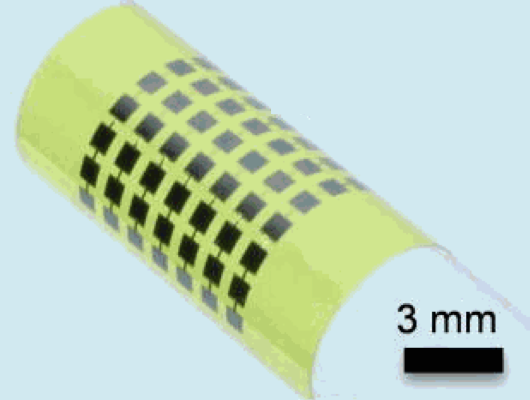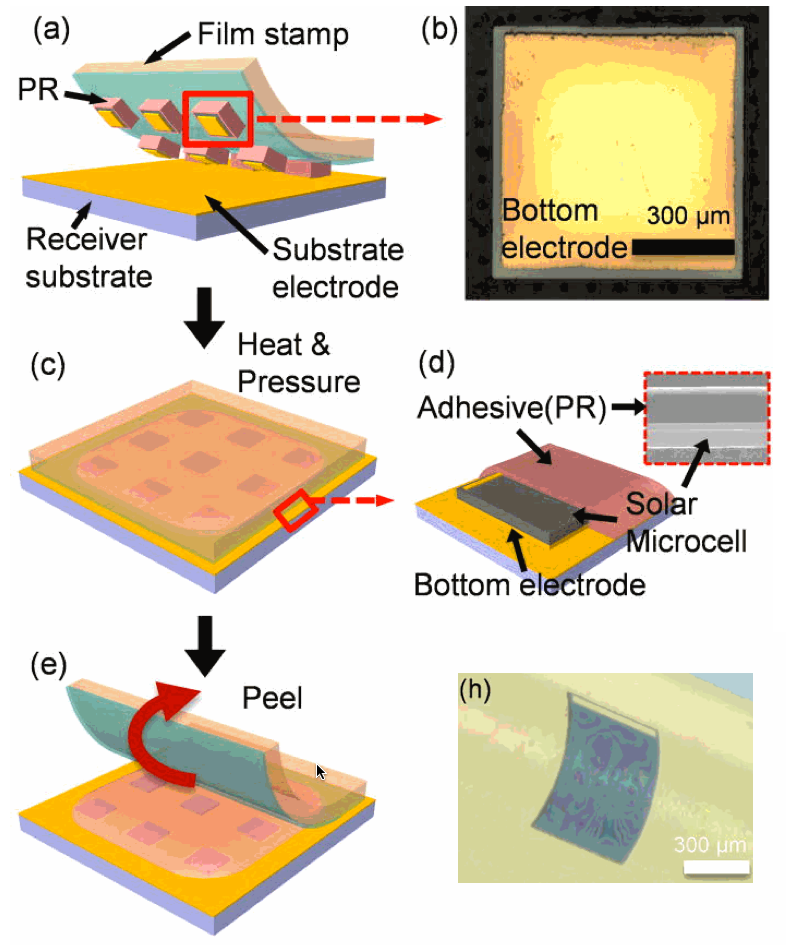Ultra-flexible solar cells thin enough to wrap around a glass stirring rod
June 20, 2016

Ultra-thin solar cells flexible enough to bend around small objects, such as this 6-mm-diameter glass rod (credit: Juho Kim, et al./APL)
Scientists in South Korea have designed ultra-thin photovoltaics that are flexible enough to wrap around a thin glass rod. The new solar cells could power wearable electronics like smart watches and fitness trackers.
“Our photovoltaic is about 1 micrometer thick” (the thinnest human hair is about 17 micrometers), said Jongho Lee, an engineer at the Gwangju Institute of Science and Technology in South Korea. Standard photovoltaics are usually hundreds of times thicker, and most other thin photovoltaics are 2 to 4 times thicker, he explained.

Fabrication procedure of the flexible vertical ultra-thin gallium-arsenide solar microcells.* (credit: Juho Kim, et al./APL)
The researchers made the ultra-thin solar cells from the semiconductor gallium arsenide. They stamped the cells directly onto a flexible substrate without using an adhesive (which would add to the material’s thickness).
The cells were then “cold welded” to the electrode on the substrate by applying pressure at 170 degrees Celsius and melting a top layer of material called photoresist, which acted as a temporary adhesive. The photoresist was later peeled away, leaving the direct metal-to-metal bond.
The metal bottom electrode layer also serves as a reflector to direct stray light back to the solar cells (to increase current output). The researchers tested the efficiency of the device at converting sunlight to electricity and found that it was comparable to thicker photovoltaics.
The team performed bending tests and found the cells could wrap around a radius as small as 1.4 millimeters. They also performed numerical analysis of the cells, finding that they experience one-fourth the amount of strain of similar cells that are 3.5 micrometers thick.
A few other groups have reported solar cells with thicknesses of around 1 micrometer, but have produced the cells in different ways, for example, by removing the whole subtrate by etching. By transfer-printing instead of etching, the new method developed by Lee and his colleagues could be used to make very flexible photovoltaics with a smaller amount of materials, according to Lee.
The thin cells can also be integrated onto glasses frames or fabric and might power the next wave of wearable electronics, Lee said.
The researchers report the results in an open-access paper in the journal Applied Physics Letters, from AIP Publishing.
* (a) Schematic illustration of a film stamp with vertical gallium-arsenide microcells fabricated and isolated from the epitaxially grown source wafers. The photoresist (PR) temporarily holds the solar microcells on the source wafers. (b) The bottom electrode, which also serves as a back reflector, is deposited onto the backside of the ultra-thin vertical GaAs microcells. (c) After the film stamp is brought into contact with the receiver substrate, heat (∼170 °C) and pressure (∼80 kPa) are applied to melt the PR to serve as an adhesive. (d) Cross-sectional scanning electron microscope (SEM) image of the microcell covered with the adhesive (PR) on the receiver substrate after the printing process. The bottom electrode is in direct contact with the Au layer on the receiver substrate. (e) Peeling the film stamp leaves the vertical ultra-thin solar microcells on the receiver substrate. (h) An optical image of the microcell wrapped on a glass slide with a radius of 1 mm. The microcell is encapsulated with a thin epoxy layer (thickness ∼2 μm).